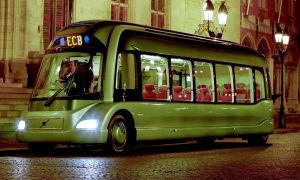Volvo Environmental Concept Bus
| Volvo ECB | |
|---|---|
 The Environmental Concept Bus. The Environmental Concept Bus. | |
| Vehicle | Volvo Environmental Concept Bus |
| Origin |
|
| Type | MR concept bus |
| Produced | 1995 - 1995 |
| Appeared in | Top Gear: Series 35, Episode 3 (1996) |
The Volvo Environmental Concept Bus, or ECB for short, was a concept bus produced by Swedish automaker Volvo as part of their Volvo Environmental Concept series of vehicles, which began with the Volvo Environmental Concept Car in 1992. Costing £15 million to design and build, the vehicle was powered[1] by a hybrid gas turbine/electric drivetrain, most of which was stored in the bus' roof. The ECB was designed with the intent of showcasing potential future innovations to be used on future buses, such as a low-floor design. Some of the design elements employed by the ECB were later used by bus manufacturers, including Volvo.
The bus was built entirely out of aluminium, and around a rollcage designed to protect its occupants in the event of a crash. The seats are part of this rollcage construction, and computers are used to stabilise the ECB when driving over rough or uneven terrain. If the ECB were to roll, a trap door in the floor can open to allow passengers to exit safely.
Appearance[edit | edit source]
After testing the company's Environmental Concept Truck, Top Gear host Tony Mason also took the Environmental Concept Bus out for a test drive. He remarks that it's very similar to the ECT, but whilst that felt like a Concorde, the ECB feels more like the Starship Enterprise. After driving the bus around a circuit, there's a brief interview from Volvo engineer Kerstin Sterner, who suggests that the gas turbine might be too excessive and that alternative hybrid drivetrains employing the use of petrol or diesel power may be experimented with in the coming years.